
Fist Stick Knife Gun
A Personal History of Violence
فرمت کتاب
ebook
تاریخ انتشار
2013
Lexile Score
1020
Reading Level
6-8
نویسنده
Jamar Nicholasناشر
Beacon Pressشابک
9780807044506
کتاب های مرتبط
- اطلاعات
- نقد و بررسی
- دیدگاه کاربران
نقد و بررسی

October 4, 2010
Canada, a legendary educator and crusader for inner-city-youth, first published in 1995 his revelatory account of the daunting push toward violent behavior that was a part of his Bronx childhood. This graphic adaptation by Nicholas works as a kind of youth-friendly summary of that book's conclusions. Canada's thoughtful, no-nonsense narrative begins in the Bronx in the late 1950s, after his father left him, his mother, and two brothers to fend for themselves. The spine of the story is not so much the broad array of violence on display in a neighborhood suffering from postwar white flight and increases in crime, but Canada's surgical analysis of the stages of violence and the strictly codified strata that reigned on his street and in his school. Helped by Nicholas's dramatic but low-key illustrations, Canada describes how he graduated from one level of violence to the next in a sort of ladder of self-protection. This inexorable evolution is dismaying enough before Canada moves ahead to show how those codes of violence eventually collapsed under an influx of guns. This is exactly the sort of broadly appealing and gripping nonfiction graphic novel that librarians need to be adding to their shelves.

November 15, 2010
The original text of this brutally honest 1995 memoir of a Bronx, NY, childhood intersperses commentary and persuasive recommendations with accounts of actual experiences: from witnessing his brothers' struggle as six-year-olds to reclaim a stolen jacket to learning to fight himself by age 12 and then in college packing a gun for the feeling of immortality it gave him. But Canada finally said no to violence, earning degrees from Bowdoin and Harvard and founding Harlem Children's Zone, a model for the Obama-Biden "Promise Neighborhoods," designed to assist urban areas with high crime and low student academic achievement. Challenged with adapting Canada's complex book into a one-volume graphic novel, Nicholas (The Grosse Adventures series) has judiciously focused on the personal end, and his semirealistic black-to-grayscale art has just the right lived-in-yet-edgy feel. Adding brown hues would have upped the vibrancy, though. VERDICT Canada's original earned raves from reviewers as well as from Oprah, who called Canada "an angel from God." Nicholas's version infuses an emotional immediacy and makes Canada's message into a personal parable accessible to a wider age range. Highly recommended for tweens through adults; violence and strong language.--M.C.
Copyright 2010 Library Journal, LLC Used with permission.

November 15, 2010
Grades 7-12 This adaptation of Canadas 1996 book joins G. Neris Yummy: The Last Days of a Southside Shorty (2010) and Robert Renterias Mi Barrio (2010) in a recent graphic mini-trend of gritty urban biographies. But while the former was about how the violence of the streets can corrupt and destroy and the latter was about how to escape it, Canadas story is about recognizing the inevitability of violence and learning to live with it. The tale, told through 10 situations from Canadas childhood and teen years on the streets of the South Bronx, is a minutely detailed study of the politics of violence, the power dynamics it creates, the relationships it engenders, how to take it, how to dish it out, and how, in essence, to take control of it and not let it ruin you. The caricatured faces that populate the story show off the innocence, the hatred, and the fear in each person and highlight the simple human truth of the unfortunate message: accepting violence is not the most hopeful prospect, but to many readers, it maybe the most realistic one.(Reprinted with permission of Booklist, copyright 2010, American Library Association.)

























دیدگاه کاربران